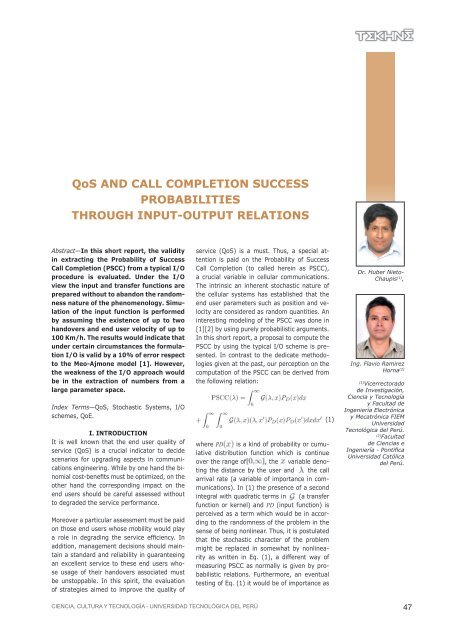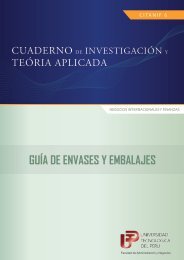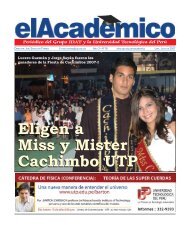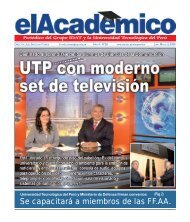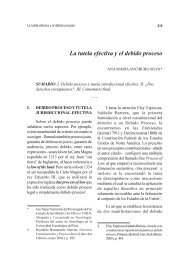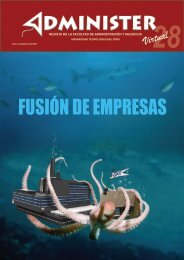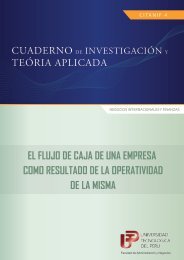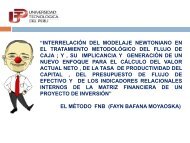Descargar - UTP
Descargar - UTP
Descargar - UTP
Create successful ePaper yourself
Turn your PDF publications into a flip-book with our unique Google optimized e-Paper software.
QoS AND CALL COMPLETION SUCCESS<br />
PROBABILITIES<br />
THROUGH INPUT-O<strong>UTP</strong>UT RELATIONS<br />
Abstract—In this short report, the validity<br />
in extracting the Probability of Success<br />
Call Completion (PSCC) from a typical I/O<br />
procedure is evaluated. Under the I/O<br />
view the input and transfer functions are<br />
prepared without to abandon the randomness<br />
nature of the phenomenology. Simulation<br />
of the input function is performed<br />
by assuming the existence of up to two<br />
handovers and end user velocity of up to<br />
100 Km/h. The results would indicate that<br />
under certain circumstances the formulation<br />
I/O is valid by a 10% of error respect<br />
to the Meo-Ajmone model [1]. However,<br />
the weakness of the I/O approach would<br />
be in the extraction of numbers from a<br />
large parameter space.<br />
Index Terms—QoS, Stochastic Systems, I/O<br />
schemes, QoE.<br />
I. INTRODUCTION<br />
It is well known that the end user quality of<br />
service (QoS) is a crucial indicator to decide<br />
scenarios for upgrading aspects in communications<br />
engineering. While by one hand the binomial<br />
cost-benefits must be optimized, on the<br />
other hand the corresponding impact on the<br />
end users should be careful assessed without<br />
to degraded the service performance.<br />
Moreover a particular assessment must be paid<br />
on those end users whose mobility would play<br />
a role in degrading the service efficiency. In<br />
addition, management decisions should maintain<br />
a standard and reliability in guaranteeing<br />
an excellent service to these end users whose<br />
usage of their handovers associated must<br />
be unstoppable. In this spirit, the evaluation<br />
of strategies aimed to improve the quality of<br />
CIENCIA, CULTURA Y TECNOLOGÍA - UNIVERSIDAD TECNOLÓGICA DEL PERÚ<br />
service (QoS) is a must. Thus, a special attention<br />
is paid on the Probability of Success<br />
Call Completion (to called herein as PSCC),<br />
a crucial variable in cellular communications.<br />
The intrinsic an inherent stochastic nature of<br />
the cellular systems has established that the<br />
end user parameters such as position and velocity<br />
are considered as random quantities. An<br />
interesting modeling of the PSCC was done in<br />
[1][2] by using purely probabilistic arguments.<br />
In this short report, a proposal to compute the<br />
PSCC by using the typical I/O scheme is presented.<br />
In contrast to the dedicate methodologies<br />
given at the past, our perception on the<br />
computation of the PSCC can be derived from<br />
the following relation:<br />
where PD is a kind of probability or cumulative<br />
distribution function which is continue<br />
over the range of , the variable denoting<br />
the distance by the user and the call<br />
arrival rate (a variable of importance in communications).<br />
In (1) the presence of a second<br />
integral with quadratic terms in (a transfer<br />
function or kernel) and PD (input function) is<br />
perceived as a term which would be in according<br />
to the randomness of the problem in the<br />
sense of being nonlinear. Thus, it is postulated<br />
that the stochastic character of the problem<br />
might be replaced in somewhat by nonlinearity<br />
as written in Eq. (1), a different way of<br />
measuring PSCC as normally is given by probabilistic<br />
relations. Furthermore, an eventual<br />
testing of Eq. (1) it would be of importance as<br />
(1)<br />
Dr. Huber Nieto-<br />
Chaupis (1) ,<br />
Ing. Flavio Ramirez<br />
Horna (2)<br />
(1) Vicerrectorado<br />
de Investigación,<br />
Ciencia y Tecnología<br />
y Facultad de<br />
Ingeniería Electrónica<br />
y Mecatrónica FIEM<br />
Universidad<br />
Tecnológica del Perú.<br />
(2) Facultad<br />
de Ciencias e<br />
Ingeniería - Pontifica<br />
Universidad Católica<br />
del Perú.<br />
47


